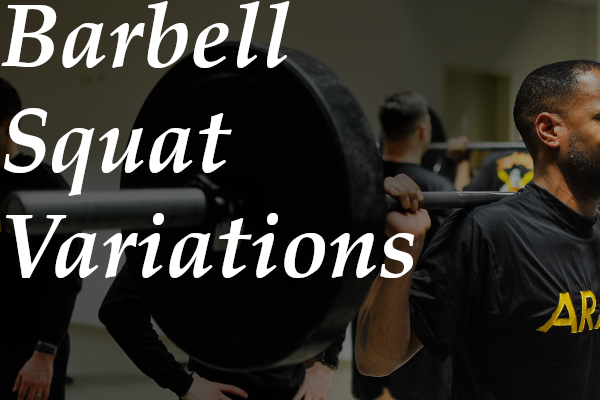Hate Squats? Try these 10 Squat Substitutions

Barbell back squats are known for building overall leg muscle strength, endurance, and mass. That doesn't mean they're essential or necessary for everyone. Below are some back squat alternatives for various goals and medical conditions.
Sit-to-Stand
The sit-to-stand exercise is exactly what it sounds like - the participant sits down and stands up. You can use a chair, weight bench, step platform, or anything else that you're confident will hold your weight. This exercise is perfect for senior citizens and overweight people starting their fitness journey. It is also a great squat regression for individuals post-operative physical therapy or post-rehabilitation.
Sit-to-stand progression: try the split stance sit-to-stand, one foot a foot ahead of the other. Want to go further, keep one foot off the floor for a one legged pistol squat regression.
TRX Squat
The TRX squat helps people with balance insecurities more confidence in their movement and oftentimes more range of motions. Its a simple, non-intimidating introduction to the TRX suspension trainer, particularly for new exercisers. Its a solid warm-up for TRX circuit training sessions. Lastly, its good preparation for advanced progressions. My go-to progression: TRX front squats.
I prefer to start with the handles held taut to the side of my hips. This starting position carries over to various TRX "stand-facing (SF)" exercises.
Kettlebell Goblet Squat
Kettlebell goblet squats are beneficial for those who want to target the quads, dislike having the barbell on the back of their neck, and prefer higher reps with lighter weight. You can substitute the kettlebell (KB) for a single dumbbell. I like to super-set goblet squats with kettlebell swings to target endurance and power while raising the heart rate. You can use the same single kettlebell for each exercise.
If you want a deeper squat, simply push the kettlebell out front when you descend to the bottom. Then, bring the kettlebell back to your chest as you stand up.
2-Kettlebell Front Squat
An advanced variation of the goblet squat, using two kettlebells allows you to add more resistance, even if you lack access to heavier ones. I like to combine these with dumbbell presses, an exercise known as the squat thruster, and super-set with bent-over kettlebell rows.
Step-Up
The forward step-up is a good single-leg exercise for various reasons. Step-ups can help someone learn to balance on one leg while moving under load. You can use one instead of two dumbbells and hold on to something for support. They can mitigate leg muscle imbalances. You can do them laterally to better work the abductors and adductors. You can change the emphasis from the quadriceps (front of thighs) to the gluteus maximus (booty meat) by adjusting the platform height. Finally, it builds a foundation of stabilization for advanced single-leg exercises.
TRX Rear Lunge
The TRX rear lunge is my preference for personal training clients with the strength for lunges, but not the stabilization. The TRX straps provide support and comfort while I coach them through lunging correctly. That usually means teaching how to kneel without overcompensating for the worry of the forward knee going over the toes.
I prefer to start with the handles at the hips same as with the TRX squat. I also allow the ball of the back foot to touch the floor for better support.
Lunge
There's a body-weight or weighted lunge variation suitable for every exercisers' goal. I sometimes start leg workouts with jumping lunges for power training. I love walking dumbbell lunges for single-leg strength and endurance. Curtsy lunges are good for emphasizing abductors, adductors, and other stabilizer muscles.
Romanian Deadlift (RDL)
Romanian deadlifts (RDLs) target the entire posterior chain (hamstrings, glutes, and lower back), enforces proper hip-hinge positioning for bent-over upper body exercises, and can help reduce lower back pain. This deadlift variation shortens the range of motion, allowing you to use more weight or complete more reps. You've probably heard the phrase "don't lift with your back." Done correctly, the RDL mimics how to lift with your lower back muscles (Erector spinae) safely.
If you reach a point where you need heavier dumbbells for RDLs but lack access, try single-leg romanian deadlifts.
Resist the urge to look up the entire time. Keep your head in a neutral position so as not to strain the neck or spine.
Deadlift
One of the "big 3" exercises, which includes the squat and bench press, the deadlift primarily strengthens the posterior chain, grip, and overall core. I recommend that seniors and others not focused on strength use kettlebells because their handles are higher than dumbbells. You can grab one kettlebell per hand or a single one in the center of the body.
When doing deadlifts and other exercises targeting the lower back, remember that lower back endurance is more important than strength for mitigating low back pain.
Wall Sit
The wall sit is last on my list because I prefer to super-set the isometric movement with other leg exercises or add in circuit training sessions as "active recovery." You can place weights on your thighs, or simply increase the duration of the hold, to increase the difficulty.
Featured image from Wikimedia.





